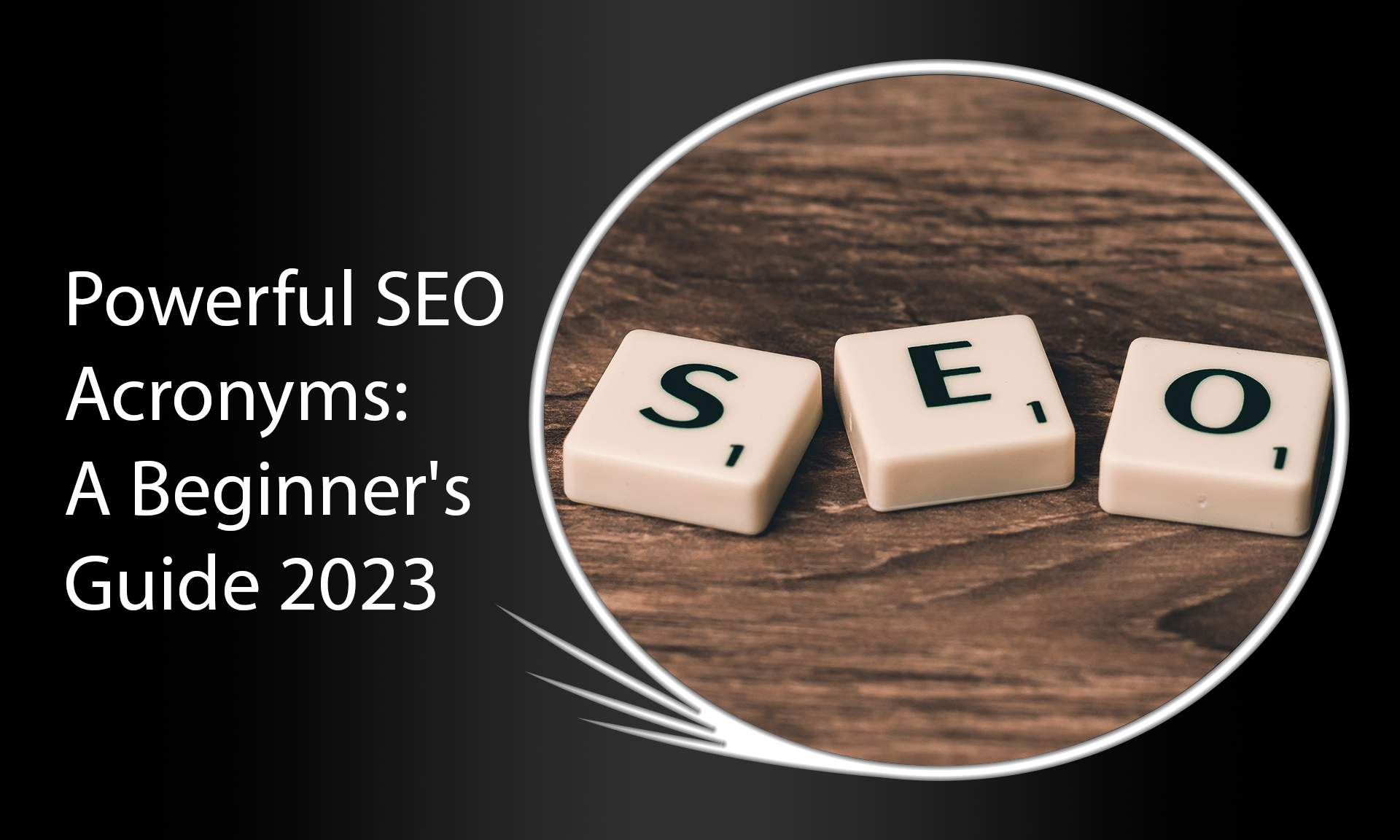SEO acronyms are a basic component of the digital marketing industry. Understanding the words behind an acronym is critical, and customers depend on them every day to keep digital marketing in line irrespective of where they are. Learning SEO acronyms may be time-consuming, but it is essential to skilled and comprehensive SEO work. It’s important to work towards mastering each letter and offer comprehensive SEO solutions to customers at every level.
To give you a head start, let’s go through a beginner’s guide to SEO acronyms. By the end of this article, you’ll know the essential acronyms you’ll need. You can then cut through the parts of a conversation that don’t apply to your business. So, whether you’re new to SEO, looking to learn more, or trying to crack the code of industry jargon, we’ve got you covered!
Understanding SEO
Understanding SEO is essential for any digital marketer. SEO stands for Search Engine Optimization and refers to the practice of optimizing your website in order to rank higher in search engine results pages. This in turn drives more traffic to your website. Effective SEO requires keyword research, on-page optimization, and link building.
Keyword research involves identifying the most relevant keywords and phrases that users are searching for, related to your products or services. On-page optimization involves optimizing individual web pages in order to rank higher and earn more relevant traffic in search engines. This includes optimizing meta tags, headings, images, and text on your website.
Link building involves acquiring high-quality backlinks from other websites in order to improve the authority and credibility of your own website. Effective SEO requires a combination of these practices, as well as ongoing monitoring and adjustment to stay up-to-date with the latest algorithm updates and constantly changing search trends.
What is SEO?
SEO stands for search engine optimization. It is the process of optimizing your website to rank higher in search engine results pages (SERPs) like Google, Bing, and Yahoo.
SEO involves making changes to your website’s code, structure, and content to make it more search engine-friendly. This includes optimizing your website’s titles, tags, URLs, metadata, and more.
The goal of SEO is to improve your website’s visibility and ranking in SERPs because it can lead to more traffic, leads, and sales. With SEO, you can target specific keywords and phrases that your target audience is searching for, and then optimize your content to rank well for those keywords.
SEO is an ongoing process, and it requires time, effort, and expertise to achieve results. There are many different tactics and strategies involved in SEO, including keyword research, on-page optimization, link building, content creation, and more. By understanding and implementing these tactics, you can improve your website’s SEO and drive more traffic and leads to your business.

Why is SEO important?
SEO is important because it helps your website be visible to search engines like Google. This means that when someone searches for a product or service related to your website, they are more likely to see your content, making it easier for potential customers to find you online.
Without proper SEO, your website may be buried in search results and difficult for anyone to find. This can decrease website traffic, lower your ranking on search engines, and ultimately hurt your business.
Good SEO practices include using relevant keywords, creating quality content, and optimizing your website’s structure and design. By implementing these strategies, your website can improve its search engine ranking, grow its online presence, and attract more customers.
SEO is crucial for any business or website looking to increase visibility online. By optimizing your website for search engines, you can improve search engine rankings, increase website traffic, and ultimately attract more customers which makes you more money. Investing in SEO can be a valuable long-term strategy to help your website grow and succeed.
How does SEO work?
SEO, or Search Engine Optimization, is the process of optimizing a website to increase its visibility and ranking on search engine result pages (SERPs). It encompasses a range of tactics, including keyword research, on-page optimization, link building, and content creation. SEO aims to improve the chances of a website being found by potential visitors who are searching for relevant products or services.
The way SEO works is by focusing on understanding how search engines determine which websites to show when a user searches. Search engines use complex algorithms to index and rank websites based on various factors such as keywords, content quality, and relevance. SEO aims to optimize a website’s content and structure to meet these factors and increase its chances of ranking higher in search results.
Keyword optimization is a crucial part of SEO as it helps search engines understand what a website is about. By researching and including relevant keywords in a website’s content, headings, and meta descriptions, it becomes easier for search engines to index and rank the site for those keywords. Link building is also an essential part of SEO, as it helps to increase a website’s authority and credibility in the eyes of search engines.

What are the benefits of SEO?
Search Engine Optimization (SEO) is a vital component of digital marketing. It involves implementing strategies to increase website visibility and rankings on search engines like Google. SEO offers several benefits, such as increased website traffic and engagement, brand awareness, and higher conversion rates.
One significant advantage of SEO is increased website traffic. As your website appears higher on search engine results pages, more users will click on your site, resulting in increased website traffic. This traffic can then convert into leads and sales via your Sales Funnel, boosting overall revenue and profits. With SEO, you can also target specific keywords related to your business, making it easier for potential customers to find you.
Another significant benefit of SEO is improved brand awareness. As your website appears higher in search engines, users will begin to recognize your brand. This recognition can lead to increased brand loyalty and word-of-mouth marketing, which can improve your brand’s overall reputation. Improved brand awareness also means that users are more likely to click on your website, which can lead to increased website traffic.
What are SEO Acronyms?
One of the first things you’ll notice when diving into the world of SEO is the abundance of acronyms. From SERP to PPC, these terms can seem overwhelming at first. But fear not, this beginner’s guide will help make sense of these SEO acronyms.
One of the most common SEO acronyms you’ll encounter is SERP, which stands for Search Engine Results Page. This refers to the page that appears after a user enters a search query into a search engine like Google. The goal of SEO is to get your website to appear higher up on the SERP, ideally in the top three organic search results, as these tend to get the most clicks.
Another important set of acronyms to know are those related to paid search advertising. PPC stands for Pay-Per-Click and refers to ads where advertisers pay each time someone clicks on their ad. Advertisers use tools like Google Ads to bid on specific keywords related to their business, and the highest bidder’s ad appears at the top of the SERP. CPC, or Cost-Per-Click, refers to the amount an advertiser pays for each click on their ad.
Why are there so many SEO acronyms?
SEO involves a lot of jargon and technical terms that can be overwhelming for beginners. One reason why there are so many SEO acronyms is because it helps professionals streamline communication and save time. Instead of saying “search engine optimization” repeatedly, the term can be shortened to “SEO”.
Another reason why there are so many SEO acronyms is because of the diverse range of techniques and strategies used in SEO. To make things easier, these techniques and processes are often referred to by acronyms to save time and effort. Whether it’s on-page optimization (OPO), domain authority (DA), or keyword research (KR), acronyms make it easier to understand and communicate these complex ideas.
While some may feel that SEO acronyms add confusion and complexity to the industry, they serve an important purpose. Acronyms are used to save time, streamline communication, and simplify complex ideas. Understanding these SEO acronyms is an important part of becoming proficient in the field, allowing beginners to communicate effectively with other professionals and understand the latest strategies and techniques.
How are SEO acronyms used?
SEO acronyms are commonly used in the digital marketing industry. They allow professionals to quickly communicate complex ideas and strategies to each other. For example, a marketer may refer to a CTR (click-through rate) when discussing a campaign’s performance with a client.
Understanding SEO acronyms is crucial for anyone working in digital marketing. Many of these terms are used to measure the effectiveness of various strategies. For example, if a website has a low bounce rate, this indicates that visitors are engaged and spending time on the site.
There are countless SEO acronyms to learn, and it can be overwhelming for beginners. However, taking the time to master these terms will help marketers communicate effectively and make data-driven decisions. It’s important to remember that while SEO acronyms may seem technical, they ultimately represent goals that every marketer should strive to achieve.

What are some common SEO acronyms?
SEO acronyms can be a bit confusing for beginners. Here are some common acronyms you may come across.
One of the most common SEO acronyms is SEO itself, which stands for Search Engine Optimization. This is the practice of optimizing websites so they can rank higher in search engine results pages.
Another important SEO acronym is SERP, which stands for Search Engine Results Page. This refers to the page of results that appear after a user enters a search query.
PageRank is another important SEO acronym. It is a metric developed by Google to measure the importance and relevance of web pages. PageRank takes into account the number and quality of links pointing to a particular web page.
Common SEO Acronyms Explained
SEO, or search engine optimization, is a critical component of digital marketing. There are several SEO acronyms beginners should know to gain a better understanding of the industry. The top common SEO acronyms include SERP, CTR, and ROI.
SERP stands for search engine results page. It refers to the page that appears on the screen after typing a query into a search engine. Ranking high on the SERP can increase website traffic and visibility.
CTR stands for click-through rate, which calculates the number of clicks on a specific link divided by the number of impressions that link receives. A high CTR is essential for business success. It indicates that your website is meeting the needs of your target audience.
ROI is perhaps the most familiar SEO acronym. It means return on investment. ROI is the measure of how much revenue the business earns from an investment. An increase in revenue is a sign of successful SEO efforts.
What are off-page SEO acronyms?
Off-page SEO refers to all the activities taking place outside a website that impacts its ranking on search engine results pages. Off-page SEO acronyms are used to describe these activities. Some of the essential off-page SEO acronyms include DA, PA, TF, and CF.
Domain Authority (DA) is a metric created by Moz that predicts how likely a domain is to rank on search engine results pages. Page Authority (PA) is another Moz metric that predicts how likely a particular page is to rank on search engine results pages. Trust Flow (TF) and Citation Flow (CF) are two metrics created by Majestic that measure a website’s trustworthiness and citation impact.
Having a better understanding of these off-page SEO acronyms is essential in optimizing a website for search engines. This can help webmasters to identify areas that need improvement and develop effective strategies. By applying off-page SEO best practices, such as link building, social media marketing, and content marketing, websites can improve their ranking on search engine results pages.
What are technical SEO acronyms?
Technical SEO acronyms refer to jargon and abbreviations used in the technical aspects of optimizing a website for better search engine rankings. One of the most common acronyms in this category is HTTPS, which stands for Hypertext Transfer Protocol Secure, denoting a secure protocol for transmitting data over a network. Another critical technical SEO abbreviation is XML, which means Extensible Markup Language, an important data exchange standard, used for sitemaps and site indexing.
Structured data (SD) is another technical SEO acronym that refers to a design framework that helps search engines like Google understand the content of a website better. The framework involves adding annotations to website content, making it easier for search engines to crawl and present the information to users. Canonical URLs are another essential SEO abbreviation, which refers to a technique used to avoid duplicate content penalties. Canonicalization involves selecting the preferred URL for a web page that may have multiple versions, thus consolidating the page’s link equity.
In addition to the above-mentioned technical SEO acronyms, there are other terms used in the industry that may be less familiar to beginners. Some of these include robots.txt, URL parameters, IP address, server response codes, and HTML meta tags. Understanding these technical SEO terms and their acronyms are essential to improving website performance, reducing loading times and making it easier for search engines to understand and index the website. As a beginner, you may not need to know every technical SEO acronym, but understanding the most common ones can be helpful in optimizing a website for better visibility and ranking.
What are conversion optimization acronyms?
Conversion optimization acronyms are commonly used in digital marketing to help people understand the key metrics for improving the conversion rate on websites. The most common conversion optimization acronyms include CRO (Conversion Rate Optimization), CTAs (Calls to Action), A/B testing (split testing) and LPO (Landing Page Optimization).
CRO is the process of increasing the percentage of visitors who complete a desired action (like buying a product or subscribing to a newsletter).
CTAs are specific instructions given to a user to take a specific action (like “add to cart”).
A/B testing works by running two different versions of a webpage or email campaign against each other to see which one performs better. The version that performs better is then used to get more people to take the desired action.
LPO helps ensure that specific elements of a webpage are optimized for conversion by designing a page that has a clear purpose, a clean design, and a compelling message that encourages visitors to take action.
By understanding these conversion optimization acronyms, businesses can work to improve their conversion rates and increase sales. Continuous testing and optimization can lead to increased revenue and a better user experience.

Why Learning SEO Acronyms Is Important
Learning SEO acronyms is an important part of understanding the world of search engine optimization. It can be overwhelming to start learning about SEO because of the many acronyms used. By knowing what these acronyms mean, you’ll be able to better communicate with your team or clients.
Knowledge of SEO acronyms will help you better understand reports, metrics, and analytics data that are vital to improving your website’s search performance. For example, CTR (click-through rate) and SERP (search engine results page) are two important SEO acronyms because they help you measure and analyze your website’s performance.
How can knowing SEO acronyms help you?
Learning SEO acronyms can help you navigate the complex world of digital marketing more effectively. In the fast-paced, ever-changing online landscape, abbreviations and acronyms are used frequently to save time and space. Understanding these terms can help you communicate more effectively with other professionals in the industry.
Knowing SEO acronyms can also help you optimize your website for search engines. By understanding what terms like SERP, CTA, and CPC mean, you can make more informed decisions about your content and online advertising strategy. This can ultimately drive more traffic to your site and improve your search engine rankings.
Additionally, staying up-to-date on SEO acronyms can help you stay informed about new trends and changes in the industry. As technology evolves and new platforms emerge, new jargon and terms will inevitably emerge as well. By understanding these terms and their implications, you can stay ahead of the curve and continue to grow and succeed in your digital marketing efforts.
How can knowing SEO acronyms improve your website?
Knowing SEO acronyms can drastically improve your website’s online visibility. The first step to optimizing your website for search engines is to understand the terminology associated with the field. Some important acronyms you should know include SERP, CTR, and PPC. Familiarizing yourself with these terms allows you to better comprehend the nuts and bolts of digital marketing and SEO strategies.
When you understand SEO acronyms, you can make data-driven decisions that help bolster your website’s ranking on search engines. Metrics such as CTR (click-through rate) and SERP (search engine results page) help you analyze and modify your SEO methodology. Through the integration of these metrics and implementing new technologies, you can enhance your website’s prowess in search engine rankings.
Additionally, incorporating SEO acronyms into your content strategy will help your website rank for specific keywords. For instance, understanding the definition of PPC (pay-per-click) can aid in developing advertisements and targeting high-intent keywords. As a result, your website’s visibility increases, drawing more traffic to your site.
Ultimately, your site’s visibility directly influences the number of leads and conversions your website can generate. Incorporating SEO acronyms and terminology strengthens your base knowledge of digital marketing, allowing for a deeper understanding of how to improve your website’s efficacy in search engines and the larger online sphere. Familiarize yourself with these essential acronyms to stay ahead of digital trends and dominate the online space.
How can knowing SEO acronyms lead to more traffic?
Knowing SEO acronyms can lead to more traffic because it allows website owners to understand the terms used in the world of search engine optimization. By familiarizing yourself with common acronyms like SERP, PPC, and CTR, you can better optimize your website and content for search engines, improving its visibility and driving more traffic to your site.
This knowledge also helps website owners improve their digital marketing strategies by allowing them to communicate more effectively with SEO professionals and other marketers. This can lead to more successful collaborations, resulting in better SEO results, and ultimately, more traffic to your website.
Additionally, understanding SEO acronyms can help you stay up-to-date on industry trends and changes. This knowledge allows website owners to stay ahead of the competition and adjust their strategies as needed to maintain their rankings and drive more traffic to their site. Overall, becoming familiar with SEO acronyms is an important step in optimizing your website and increasing your online visibility.
How can knowing SEO acronyms save you money?
Knowing SEO acronyms can help you save money in many different ways. For example, understanding the meaning of terms like CTR (click-through rate) and CPC (cost per click) can help you optimize your pay-per-click (PPC) advertising campaigns to get more bang for your buck. By improving your CTR, you can increase the number of clicks you receive without spending more money on ads. Similarly, if you can decrease your CPC, you can reduce your overall advertising costs.
SEO acronyms can also help you save money by making it easier to communicate with your team, vendors, and clients. When everyone is on the same page and understands the same terminology, you can avoid misunderstandings and mistakes that can be costly to fix. For example, if you’re working with a web development agency to optimize your website, knowing the meaning of terms like HTML (hypertext markup language) and CSS (cascading style sheets) can help you provide clear instructions and avoid costly delays.
In addition, knowing SEO acronyms can help you save money by making it easier to track your progress and measure your results. For instance, if you understand the meaning of terms like SERP (search engine results page) and KPI (key performance indicator), you can set specific goals and track your progress over time. By analyzing your data using tools like Google Analytics, you can identify areas where you need to improve and optimize your website, content, and advertising campaigns to get better results without increasing your costs.
Closing
As a beginner in SEO, it is essential to understand the various acronyms used in the industry. SEO acronyms signify specific tactics and techniques that are used to optimize websites for search engines. Common SEO acronyms include SERP, CTR, and SEM; understanding their meanings can help you make sense of your SEO efforts.
SEO is an evolving field and new acronyms emerge regularly. Therefore, to stay updated and well-informed, make sure you follow SEO experts and read industry blogs. Additionally, knowing and understanding SEO acronyms can aid in improving your website’s visibility, traffic, and rankings.
Lastly, SEO acronyms serve as a language that connects SEO professionals and businesses, enabling them to communicate more efficiently and effectively about their strategies and results. By mastering SEO acronyms, you can join the conversation, understand the language, and ultimately optimize your website better. Take the time to comprehend the various acronyms used in SEO and their different meanings, as it will benefit your digital marketing efforts far beyond just SEO.

